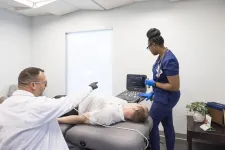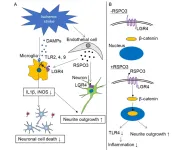(Press-News.org)
HIGHLIGHTS
Pseudomonas aeruginosa is a pathogenic and drug-resistant gram-negative bacterium
The CDC advised against using some artificial tear eye drops that were contaminated with the microbe
In November 2022, doctors in Cleveland diagnosed a patient with a corneal ulcer with a P. aeruginosa infection
The patient acquired the infection from tainted eye drops months before the CDC’s February 2023 warning
Washington, DC – In February 2023, the Centers for Disease Control and Prevention warned people against using EzriCare eye drops because bottles of the product had been linked to drug-resistant bacterial infections causing vision loss and even death. But tainted bottles had been causing problems long before then.
This week in Antimicrobial Agents and Chemotherapy, an interdisciplinary group of researchers and physicians in Cleveland, Ohio, describe a case from November 2022. The patient, a 72-year-old female, was diagnosed with a corneal ulcer, caused by infection by the bacterium Pseudomonas aeruginosa. Eventually, infectious disease physicians and microbiologists identified her contaminated eye drops as the source of the infection.
P. aeruginosa is a pathogenic, gram-negative bacterium that’s resistant to treatment with most antibiotics. It can cause swimmer’s ear — a painful infection of the outer ear canal — and more serious conditions, especially in people with compromised immune systems. But the case in Cleveland was unusual, said Morgan Morelli, M.D., the study’s first author and an infectious disease fellow at the hospital.
“I’ve never recovered it from an eye,” she said. Because P. aeruginosa isn’t usually found in eye infections, she said, finding the right diagnosis was a challenge. “It required a lot of thinking and digging to figure out what was going on,” she said. “And we never thought it was related to a global manufacturing issue.”
The patient initially reported to an outpatient eye clinic with blurry vision. From there, she was sent to the emergency department at the hospital, where she was evaluated by ophthalmologists. They cultured the infection, prescribed a combination of strong antibiotic eye drops, and sent her home. But the next day, the eye was worse—and she visited a cornea specialist.
The patient had noticed a yellow discharge on her pillow, and she hadn’t been swimming. “We wondered if she’d accidentally touched something, or there was some freak accident,” to explain the infection, Morelli said.
At that point, Morelli said, her case was referred to microbiologists and infectious disease experts at the hospital. Infectious disease specialist Scott Fulton, M.D., asked the patient’s husband to bring in her eye drops for testing. A sample from the patient was sent to the lab of Robert Bonomo, M.D., an expert in gram-negative, drug-resistant bacteria at Case Western Reserve University School of Medicine.
Then, Morelli said, the pieces came together. Dr. Bonomo’s lab identified a P. aeruginosa isolate that matched genetic material found in the EzriCare artificial tear eye drops she’d been using. Then researchers connected the eye infection—and the ulcer it had caused—to the contaminated drops.
Treatment was tricky, Morelli said. The isolate was resistant to any antibiotics that could be administered by way of the patient’s eye. She was treated instead by a strong antibiotic, cefiderocol, that has some activity against gram-negative bacterium, as well as two other topical antibiotics. The injury to her eye improved, Morelli said, but it’s unclear whether the patient will ever regain total vision.
Since issuing the warning in February, the CDC has identified infectious cases due to P. aeruginosa as early as spring 2022. “I think it took a while for this to be put together, in terms of what all these patients had in common,” said Morelli. Although the contaminated product has been pulled from stores and can no longer be purchased, it may still pose a risk.
People may still have it on their medicine cabinet shelves, Morelli said. She also hopes that the ophthalmologists and optometrists who may be the first physicians to see future patients with this infection will know what to look for. “We don’t always get this detailed of a history or ask someone to bring in over-the-counter medicine they’re using,” she said. “We really wanted to raise awareness.”
END
WHO: Dennis Selkoe, MD, co-director of the Ann Romney Center for Neurologic Diseases at Brigham and Women’s Hospital and corresponding author of the paper in Neuron. Andrew Stern, MD, PhD, of the Ann Romney Center for Neurologic Diseases at BWH and first author of the paper in Neuron
WHAT: In a report published in Neuron, a team led by investigators from Brigham and Women’s Hospital reveals the structure of the therapeutic target of lecanemab, a drug approved by the US Food and Drug Administration in January 2023 for the treatment of Alzheimer’s disease. While the ...
Much of what is now considered modern medicine originated as folk remedies or traditional, Indigenous practices. These customs are still alive today, and they could help address a variety of conditions. Now reporting in ACS Omega, a team of researchers have identified compounds in the leaves of a particular medicinal Labrador tea plant used throughout the First Nations of Nunavik, Canada, and demonstrated that one of them has activity against the parasite responsible for malaria.
“Labrador tea” refers to multiple, closely related plants — all members of the genus Rhododendron. ...
Using ESO’s Visible and Infrared Survey Telescope for Astronomy (VISTA), astronomers have created a vast infrared atlas of five nearby stellar nurseries by piecing together more than one million images. These large mosaics reveal young stars in the making, embedded in thick clouds of dust. Thanks to these observations, astronomers have a unique tool with which to decipher the complex puzzle of stellar birth.
“In these images we can detect even the faintest sources of light, like stars far less massive than the Sun, revealing objects that no one has ever seen before,” says Stefan Meingast, an astronomer at the University of Vienna in Austria and lead author ...
Cross Country Healthcare, Inc. (NASDAQ: CCRN), a market-leading, tech-enabled workforce solutions platform and advisory firm, in collaboration with Florida Atlantic University, today announced the results of its annual survey of nursing professionals and students.
The study found that although nurses are passionate about doing meaningful work and earning a good income, only one-third of nurses plan to remain in the profession for the foreseeable future, and about one-fourth plan to leave in just one to two years from now. The survey, conducted in collaboration with FAU’s Christine E. Lynn College of Nursing, found ...
How did catalytic organic polymers emerge on prebiotic Earth? Answering this essential question will unlock key understandings in the origin of life.
A team of scientists at Tohoku University have recently found a potential environment for the reaction that produced catalytic organic polymers. To do so, they dried down amino acid solutions containing boric acid and found that boric acid catalyzes polypeptide synthesis under neutral and acidic conditions. The longest peptides formed in the experiments were 39 monomer-long glycine polypeptides under a neutral condition.
Previous studies ...
Barcelona, Spain – 11 May 2023: Postmenopausal women with clogged arteries are at higher risk of heart attacks than men of similar age, according to research presented at EACVI 2023, a scientific congress of the European Society of Cardiology (ESC),1 and published in European Heart Journal - Cardiovascular Imaging.2 The study in nearly 25,000 adults used imaging techniques to examine the arteries and followed patients for heart attacks and death.
“The study suggests that a given burden of atherosclerosis ...
Osaka, Japan – Ischemic stroke, caused by a blockage of blood flow to the brain, is a common cause of death and disability. Treatments are urgently needed to improve patient outcomes, because recovery currently depends largely on the timely injection of a blood clot-dissolving drug. Priorities for therapy include limiting inflammation at the ischemic site and rebuilding neuronal connections damaged by the stroke. However, a molecule that can achieve these therapeutic effects has remained elusive.
In a study to be published in Stroke, researchers from Osaka University provide new hope for patients. They have identified ...
Astronomers have found that supermassive black holes obscured by dust are more likely to grow and release tremendous amounts of energy when they are inside galaxies that are expected to collide with a neighbouring galaxy. The new work, led by researchers from Newcastle University, is published in Monthly Notices of the Royal Astronomical Society.
Galaxies, including our own Milky Way, contain supermassive black holes at their centres. They have masses equivalent to millions, or even billions, times that of our ...
Rooftop solar arrays have the potential to meet the annual electricity demands of up to 35% of US manufacturing sectors.
On-site sources of renewable energy currently supply less than 0.1% of industrial electricity demand in the US.
The industrial sector accounts for 38% of global energy consumption and 37% of greenhouse gas emissions.
Despite having the potential to cover 13.6% of the national electricity demand, rooftop solar arrays currently account for just 2.2% of the electricity grid mix.
Mounted on the rooftops ...
Students in Sweden are positive towards AI tools such as ChatGPT in education, but 62 percent believe that using chatbots during exams is cheating. However, where the boundary for cheating lies is highly unclear. This is shown in a survey from Chalmers University of Technology, which is the first large-scale study in Europe to investigate students' attitudes towards artificial intelligence in higher education.
“I am afraid of AI and what it could mean for the future.”
“Don't worry so much! Keep up with the development and adapt your teaching ...







